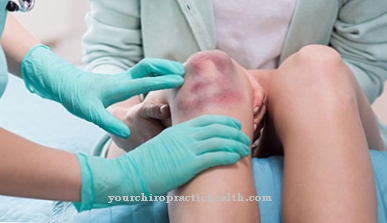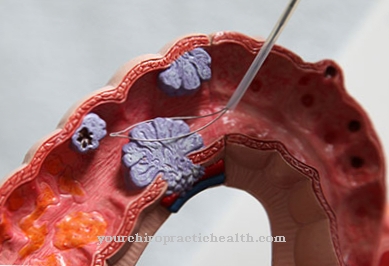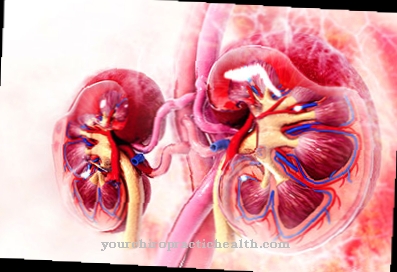Rhinorrhea is the medical term for the commonly known runny nose. Causes for this range from a cold or allergy to severe head injuries. There are a variety of treatment options for acute rhinorrhea.
What is rhinorrhea?

© galitskaya - stock.adobe.com The term Rhinorrhea comes from the Greek and describes something like: Elimination from the nose. Accordingly, rhinorrhea would generally be referred to as the discharge of fluids from the nose.
It's a common symptom of hay fever and a common cold or flu. However, it's also a sign of drug withdrawal. The rhinorrhea is caused by an inflammation of the tissue and vessels in the entire nasal area.
Colloquially, rhinorrhea is also often referred to simply as runny nose designated. Aside from allergic causes or a cold, rhinorrhea can also be associated with the excretion of cerebral tissues; usually this is the result of a skull fracture.
causes
The Rhinorrhea is ascribed not to a single but to a multitude of causes. This includes:
Allergies: People with hay fever will be very familiar with the runny nose. But other allergens such as animal hair, soy, latex, grain, etc. can also express their effects in rhinorrhea. In this case it is also called allergic rhinorrhea.
Infection: Both viral and bacterial infections can cause rhinorrhea.
Bronchiolitis: Is a viral infection in the lungs that is a common cause of rhinorrhea onset, especially in children.
sinus infection: This is common with colds and causes inflammation and swelling in the walls of the bone cavities around the nose and eyes.
Spicy food: Well-seasoned foods or the vapors of certain foods (e.g. onions) temporarily lead to an increased production of nasal discharge in many people.
Head injuries: This can also lead to rhinorrhea and is to be assessed as particularly serious.
Symptoms, ailments & signs
Rhinorrhea manifests itself primarily in the sick person's nose running. A secretion occurs from the nose, which, depending on the underlying disease, can be clear and watery or yellow and solid. Rhinorrhea can be associated with reddening of the nose. Depending on the trigger, other symptoms and complaints can be added to the runny nose.
If the runny nose is caused by a cold, it can also lead to hoarseness, chapped lips and headaches. If the flu is the cause, muscle and limb pain, but also serious respiratory problems and inflammation can set in. If the symptoms are based on an allergy, the typical symptoms of an allergic shock occur: breathing difficulties, irritated eyes, skin changes, malaise.
The runny nose usually comes on suddenly when the person steps out into the fresh air or enters an interior room. The trigger is increased blood flow to the nose. Correspondingly, the nose becomes reddened and overheated. The rhinorrhea usually disappears after a few minutes. If you have a cold, the runny nose can persist for several days. The color and consistency of the secretions change over time.
Diagnosis & course
The specific symptoms of Rhinorrhea are an indicator of their cause. The medical examination includes a scan of the nose and face, especially around the sinuses. Even a slight pressure on inflamed areas can cause pain in the person affected.
The color and shape of the nasal discharge is also included in the diagnosis. The discharge may also be analyzed in the laboratory to determine the exact cause.
Patients with severe sinusitis, diabetes, and conditions related to the immune system may need computed tomography to make an accurate diagnosis and determine if the rhinorrhea is healing or chronic.
Complications
In most cases, this complaint does not cause any particular complications. Rhinorrhea occurs mainly during the flu or cold and is one of the common symptoms. Even after the illness, the runny nose can persist and complicate the patient's everyday life. Complications usually only arise if the complaint persists over a long period of time and does not go away on its own.
The affected person can also suffer from diabetes or from inflammation of the sinuses. The further course of the disease depends heavily on the underlying disease, so that a general prognosis cannot be given in most cases. In the case of a common cold or flu, the illness can be treated with simple means and the symptoms relieved.
Again, there are no particular complications or other complaints. However, the treatment of the underlying disease is also necessary in order to completely limit the symptoms. Nasal rinsing can also lead to a positive course of the disease. The life expectancy of the person affected is usually not negatively affected by the disease.
When should you go to the doctor?
If the nose is constantly runny, the underlying condition may be serious. A doctor is advised if the rhinorrhea is related to nasal polyps or sinusitis. If the symptoms develop after inhaling irritating substances such as dust or chemicals, it is best to consult a doctor directly. Other triggers can be cluster headaches, tumors of the nose or sinuses, and allergies. The risk groups should consult their family doctor if the runny nose becomes a burden or is associated with other symptoms such as shortness of breath or pain in the area of the olfactory organs.
Rhinorrhea is also treated by an ear, nose and throat doctor or allergist. The doctor can make the diagnosis based on a medical history and an examination of the nose and sinuses. If done early, inflammation and other complications can be averted. In addition, there is an increased risk of infection for other people due to a runny nose. Therefore, rhinorrhea should always be examined by a doctor and treated if necessary.
Treatment & Therapy
Treatment of the Rhinorrhea depends on its cause. As a rule, it does not require any treatment and will go away on its own. Unless it is a symptom of a severe neurological or physical problem.
Medically, rhinorrhea can be treated with the help of antihistamines such as the trademarks Claritin®, Zyrtec®, Tylenol®, Tavist®, and Benadryl®. Decongestants like oxymetazoline and pseudoephedrine have a similar effect. These remedies stop the discharge or noticeably minimize it. In addition to decongestants and antihistamines, sympathomimetics can also be used for treatment. The use of nasal sprays is also a proven remedy for acute rhinorrhea, but should not be overdosed, as it can otherwise have a negative effect.
Sprays and antihistamines usually do not require a prescription, but should be taken in consultation with your doctor to ensure effective treatment. By diluting the discharge, there is also relief for the person affected. This can be achieved through regular nasal rinsing with a light saline solution and a damp room climate.
You can find your medication here
➔ Medicines for colds and nasal congestionprevention
A possible prevention of Rhinorrhea depends on the specific causes. Allergy sufferers are well advised to avoid the causative allergens. Viral and bacterial infections are more difficult to prevent. Regular hand washing and avoiding contact with people with a cold can help. The susceptibility to colds and the associated rhinorrhea can be reduced by eating a healthy diet and being in good physical condition.
Aftercare
Follow-up care for rhinorrhea is based on the underlying disease. If the discharge occurs in connection with acute rhinitis, extensive follow-up care is not required. The rhinorrhea subsides as soon as the rhinitis has been cured. As part of the follow-up care, the continued use of the prescribed rhinology drugs or antibiotics must be discussed.
In addition, the doctor inquires about any secondary symptoms and, if necessary, carries out a physical examination to detect inflammation or other abnormalities in the area of the throat, nose and ears. Long-term treatment is necessary if the rhinorrhea is based on cluster headache. Follow-up care focuses on controlling symptoms and preventing recurrence after rhinorrhea goes away.
In the case of special forms such as rhinoliquorrhea or pseudo-rhinoliquorrhea, individual measures must be taken. It is best for patients to talk to their ENT doctor about the necessary measures. Follow-up care for rhinorrhia can take months or years if chronic symptoms such as cluster headache or chronic infectious rhinitis are the cause of the uncontrolled discharge. Aftercare for rhinorrhea is carried out by an ENT doctor. In the event of allergic complaints, the allergist or family doctor is responsible.
You can do that yourself
Depending on the cause of the rhinorrhea, there are different treatment options. If the symptoms are due to a cold, therapy is not necessary. The symptoms go away by themselves as soon as the underlying disease has been cured. Allergic symptoms must be treated causally by reducing contact with the allergen.
If bronchiolitis or sinusitis is the cause, general measures such as rest and rest will help. The nasopharynx should not be exposed to irritation. If the rhinorrhea occurs in connection with a head injury, the flow of secretions can be stopped by cooling and bandages. The doctor can prescribe a suitable nasal spray. If the symptoms occur after eating spicy food or after going outdoors, cleaning your nose is sufficient.
The rhinorrhea must be examined by a doctor if it occurs repeatedly or does not go away on its own. Home remedies such as cooling and inhalations help as well as homeopathic preparations such as essential oils or ointments with aloe vera and mint. At the same time, the loss of fluids must be compensated for by regularly drinking mineral water or tea. Children, the elderly and the chronically ill in particular should drink a lot to avoid dehydration.



.jpg)




















.jpg)



